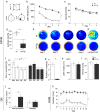Learning deficits in rats overexpressing the dopamine transporter
- PMID: 30242292
- PMCID: PMC6154965
- DOI: 10.1038/s41598-018-32608-7
Learning deficits in rats overexpressing the dopamine transporter
Abstract
With its capacity to modulate motor control and motivational as well as cognitive functions dopamine is implicated in numerous neuropsychiatric diseases. The present study investigated whether an imbalance in dopamine homeostasis as evident in the dopamine overexpressing rat model (DAT-tg), results in learning and memory deficits associated with changes in adult hippocampal neurogenesis. Adult DAT-tg and control rats were subjected to the Morris water maze, the radial arm maze and a discrimination reversal paradigm and newly generated neurons in hippocampal circuitry were investigated post mortem. DAT-tg rats were found to exhibit a striking inability to acquire information and deploy spatial search strategies. At the same time, reduced integration of adult-born neurons in hippocampal circuitry was observed, which together with changes in striatal dopamine signalling might explain behavioural deficits.
Conflict of interest statement
The authors declare no competing interests.
Figures




References
Publication types
MeSH terms
Substances
Grants and funding
- 01EW1409/Bundesministerium für Bildung und Forschung (Federal Ministry of Education and Research)/International
- 01EE1403A/Bundesministerium für Bildung und Forschung (Federal Ministry of Education and Research)/International
- WI 2140/3-1/Deutsche Forschungsgemeinschaft (German Research Foundation)/International
LinkOut - more resources
Full Text Sources
Other Literature Sources
Medical
Miscellaneous

